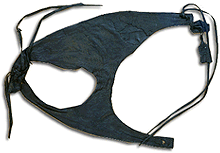This is an old revision of this page, as edited by JzG (talk | contribs) at 07:38, 1 December 2006 (WP:FUC, not valid in this article). The present address (URL) is a permanent link to this revision, which may differ significantly from the current revision.
Revision as of 07:38, 1 December 2006 by JzG (talk | contribs) (WP:FUC, not valid in this article)(diff) ← Previous revision | Latest revision (diff) | Newer revision → (diff)

A bikini or two-piece is a type of women's swimsuit, characterized by two separate parts—one covering the breasts, the other the groin (and optionally the buttocks), leaving an uncovered area between the two garments. The shapes of both parts of a bikini closely resemble women's underwear, and the lower part of a bikini can therefore range from the more revealing thong or g-string to briefs and the more modest square-cut shorts.
Two-piece garments worn by women for athletic purposes have been observed on Greek urns and paintings, dated as early as 1400 BC.
Sometimes the term bikini is used to describe the type of man's swimsuit also known as speedos.
Modern origin
According to the official version, the modern bikini was invented by French engineer Louis Réard and fashion designer Jacques Heim in Paris in 1946 and introduced on July 5 at a fashion show at Piscine Molitor in Paris. It was a string bikini with a g-string back. It was named after Bikini Atoll, the site of nuclear weapon tests a few days earlier in the Marshall Islands, on the reasoning that the burst of excitement it would cause would be like the thermonuclear device. However, women in Paris were wearing bikinis one year before the bikini was "invented". This fact is documented with pictures in the July 16, 1945 issue of Life. Film of holidaymakers in Germany in the 1930's show women wearing two-piece bathing suits.
Of course the magazine article did not attach the name "bikini" to the swimsuit. At that time the atomic bomb test was a year in the future and virtually no one had ever heard of Bikini Atoll. The article instead spoke of the "French Bathing Suits". But although the name had not yet been adopted, the swimsuits that the Parisian women were wearing are clearly recognizable as bikinis in style and coverage.
Coincidentally, the date of publication of the magazine, July 16, 1945, was the very same day that the first atomic bomb was detonated in the desert outside Alamogordo, New Mexico.
Reard's suit was a refinement of the work of Jacques Heim who, two months earlier, had introduced the "Atome" (named for its size) and advertised it as the world's "smallest bathing suit". Reard 'split the "atome"' even smaller, but could not find a model who would dare to wear his design. He ended up hiring Micheline Bernardini, a nude dancer from the Casino de Paris as his model.
Bikinis in modern culture
In 1951 bikinis were banned from the Miss World Contest. In 1957, however, Brigitte Bardot's bikini in And God Created Woman created a market for the swimwear in the US, and in 1960, Brian Hyland's pop song "Itsy Bitsy Teenie Weenie Yellow Polka Dot Bikini" inspired a bikini-buying spree. Finally the bikini caught on, and by 1963, the movie Beach Party, starring Annette Funicello (emphatically not in a bikini, by mentor Walt Disney's personal request) and Frankie Avalon, led a wave of films that made the bikini a pop-culture symbol.
In Malta bikinis took time to be introduced. In the 1960s the police fended off Bishop Michael Gonzi's request to ban bikini clad tourists following fear of compromising Malta as a tourist destination. Malta Labour Party girls felt protected to put on bikinis during beach parties but this was unacceptable by those supporting the Nationalist Party.
People who are familiar with the history of Bikini Atoll—particularly opponents of nuclear proliferation—may find the etymology and use of the word "bikini" for a garment as inappropriate, as its tongue-in-cheek "explosive" reputation effectively reduces the significance of a serious historic humanitarian crisis—one that still influences the politics of the Marshall Islands—to a mere popular culture sex symbol in the minds of most people. The term two-piece is considered a neutral alternative.

Many magazines market themselves by placing a woman in a bikini on the cover. Because of the influence of the media, some women try to lose weight before the summer so they can have the ideal "bikini body". These weight loss goals are often unrealistic and unhealthy in their means and result. The image of the bikini in the media sometimes brings about eating disorders in people striving to have the "perfect" body.
Evolution of the bikini
| This article does not cite any sources. Please help improve this article by adding citations to reliable sources. Unsourced material may be challenged and removed. Find sources: "Bikini" – news · newspapers · books · scholar · JSTOR (October 2006) (Learn how and when to remove this message) |
In recent years, the term monokini has come into use for topless bathing by women: where the bikini has two parts, the monokini is the lower part. Where monokinis are in use, the word bikini may jokingly refer to a two-piece outfit consisting of a monokini and a sun hat. The term was coined by Rudi Gernreich.
The tankini is a swimsuit combining a tank top and a bikini bottom.
The string bikini is a renovation of the traditional bikini that generally consists of the barest minimal fabric coverage for the top and bottoms, both are reduced to triangles of cloth connected by strings. For some women, the string bikini may actually be the most flattering bikini style. The string bikini style looks best on women with small busts or boyish shapes. Because women with small breasts do not need a large amount of bra-style support, a traditional triangle top can serve to add more shape and curve to the breasts. In addition, triangle tops with built-in under wires can work similarly to a push-up bra to maximize the breasts.
The lower part of the bikini was further reduced in size in the 1970s to the Brazilian thong, where the back of the suit is so thin that it disappears into the buttocks.
Female athletes who play beach volleyball professionally are required to wear two-pieces.
Media depiction
The obvious sex appeal of the apparel prompted numerous film and television productions as soon as public morals changed to accept it. They include the numerous surf movies of the early 1960s and the television series, Baywatch. Iconic portrayals of bikinis in movies include Ursula Andress as Bond girl Honey Ryder in Dr. No (1962), Raquel Welch as the prehistoric cavegirl in the 1966 film One Million Years B.C., and Phoebe Cates in the 1982 teen film Fast Times at Ridgemont High. These scenes were recently ranked 1, 86, and 84 in Channel 4 (UK)'s 100 Greatest Sexy Moments (in film) respectively.
In addition, a variant of the bikini popular in fantasy literature is a bikini that is made up of metal to serve as (admittedly rather impractical) armor, sometimes referred to as a "chainmail bikini" or "brass bikini"; the character Red Sonja is a famous example. A term for such usage, where sex appeal is more important than actual practicality, is babes-at-arms (parodying "men-at-arms" for fully armoured soldiers).
In science fiction, Star Wars Episode VI: The Return of the Jedi features the notable "Princess Leia's metal bikini" costume, that is worn by the character Princess Leia when she is held captive at the film's beginning. This particular "bikini" has since been elevated to pop culture icon status, spawning various spoofs and parodies (most notably the episode of Friends,The One with the Princess Leia Fantasy) and even a dedicated fansite, Leia's Metal Bikini.
See also
- Bikini waxing
- Brazilian waxing
- Bikini contest
- Microkini
- Villa Romana del Casale (where famous ancient Roman "bikini girls" mosaic was discovered)
External links
- Bikini facts and information
- The first bikini
- "David Dodge and the Art of the Bikini"
- "A Brief History of the Bikini: How the tiny swimsuit conquered America", Slate Magazine, July 5, 2006.
- History of the Bikini
- Bikini history, trivia, and information
- bikini patents